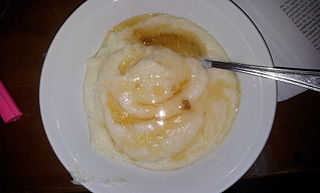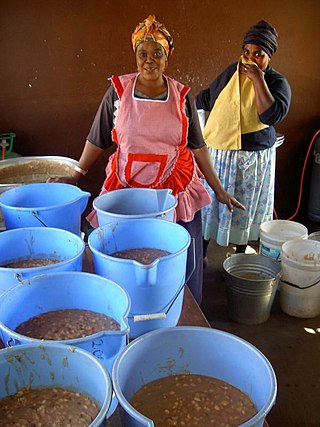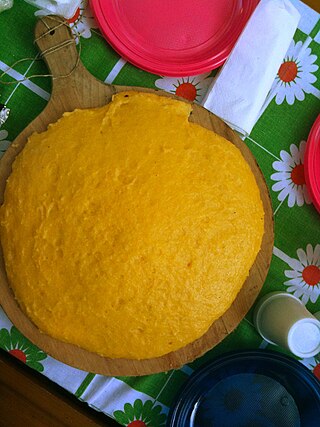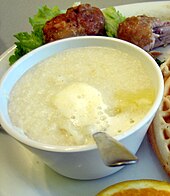
Hominy is a food produced from dried maize (corn) kernels that have been treated with an alkali, in a process called nixtamalization. "Lye hominy" is a type of hominy made with lye.

The cuisine of the Southern United States encompasses diverse food traditions of several subregions, including Tidewater, Appalachian, Ozarks, Lowcountry, Cajun, Creole, African American Cuisine and Floribbean cuisine. In recent history, elements of Southern cuisine have spread to other parts of the United States, influencing other types of American cuisine.

Porridge is a food made by heating or boiling ground, crushed or chopped starchy plants, typically grain, in milk or water. It is often cooked or served with added flavourings such as sugar, honey, fruit, or syrup to make a sweet cereal, or it can be mixed with spices, meat, or vegetables to make a savoury dish. It is usually served hot in a bowl, depending on its consistency. Oat porridge, or oatmeal, is one of the most common types of porridge. Gruel is a thinner version of porridge and congee is a savoury variation of porridge of Asian origin.

Cornmeal is a meal ground from dried corn (maize). It is a common staple food and is ground to coarse, medium, and fine consistencies, but it is not as fine as wheat flour can be. In Mexico, very finely ground cornmeal is referred to as corn flour. When fine cornmeal is made from maize that has been soaked in an alkaline solution, e.g., limewater, it is called masa harina, which is used for making arepas, tamales, and tortillas. Boiled cornmeal is called polenta in Italy and is also a traditional dish and bread substitute in Romania.

Cornbread is a quick bread made with cornmeal, associated with the cuisine of the Southern United States, with origins in Native American cuisine. It is an example of batter bread. Dumplings and pancakes made with finely ground cornmeal are staple foods of the Hopi people in Arizona. The Hidatsa people of the Upper Midwest call baked cornbread naktsi. Cherokee and Seneca tribes enrich the basic batter, adding chestnuts, sunflower seeds, apples, or berries, and sometimes combine it with beans or potatoes. Modern versions of cornbread are usually leavened by baking powder.

Mămăligă is a polenta made out of yellow maize flour, traditional in Romania, Moldova, Western Ukraine and among Poles in Ukraine, the Black Sea regions of Georgia and Turkey, and Thessaly and Phthiotis, as well as in Bulgaria (kacamak) and in Greece. It is traditional also in Italy, Switzerland, Slovenia, Croatia, Brazil, with the name polenta.

Polenta is a dish of boiled cornmeal that was historically made from other grains. The dish comes from Italy. It may be allowed to cool and solidify into a loaf that can be baked, fried, or grilled.

Peasant foods are dishes eaten by peasants, made from accessible and inexpensive ingredients.

A hush puppy is a small, savory, deep-fried round ball made from cornmeal-based batter. Hushpuppies are frequently served as a side dish with seafood and other deep-fried foods.

Ugali, also known as posho, nsima, and other names, is a type of corn meal made from maize or corn flour in several countries in Africa. It is cooked in boiling water or milk until it reaches a stiff or firm dough-like consistency. In 2017, the dish was added to the UNESCO Representative List of the Intangible Cultural Heritage of Humanity, one of a few foods in the list.
Hasty pudding is a pudding or porridge of grains cooked in milk or water. In the United States, it often refers specifically to a version made primarily with ground ("Indian") corn, and it is mentioned in the lyrics of "Yankee Doodle", a traditional American song of the 18th century.

Mielie meal, also known as mealie meal or maize meal, is a relatively coarse flour made from maize or mealies in Southern Africa, from the Portuguese milho. This is uncertain, as "mealie", in South Africa is an Afrikaans word. Etymology. Borrowed from Afrikaans mielie, from obsolete Dutch milie, from Old French mil (“millet”). It is also known by various other indigenous language names depending on the locality or country. It was originally brought to Africa from the Americas by the Portuguese.

Samp is a food made from dried corn kernels that have been pounded and chopped until broken, but not as finely ground as mealie-meal or mielie rice. The coating around the kernel loosens and is removed during the pounding and stamping process. It is eaten across South Africa and by the Lozi and Tonga people of Zambia with sugar and sour milk. It can also be served with gravy and various additives. It is cooked with beans in the Xhosa variant of umngqusho and sometimes eaten with chakalaka. It can also be served with beef, lamb, poultry and in stuffings.

Indigenous cuisine of the Americas includes all cuisines and food practices of the Indigenous peoples of the Americas. Contemporary Native peoples retain a varied culture of traditional foods, along with the addition of some post-contact foods that have become customary and even iconic of present-day Indigenous American social gatherings. Foods like cornbread, turkey, cranberry, blueberry, hominy, and mush have been adopted into the cuisine of the broader United States population from Native American cultures.

Johnnycake, also known as journey cake, johnny bread, hoecake, shawnee cake or spider cornbread, is a cornmeal flatbread, a type of batter bread. An early American staple food, it is prepared on the Atlantic coast from Newfoundland to Jamaica. The food originates from the indigenous people of North America. It is still eaten in the Bahamas, Belize, Bermuda, Canada, Colombia, Curaçao, Dominican Republic, Jamaica, Puerto Rico, Saint Croix, and the United States.

Mush is a type of cornmeal pudding which is usually boiled in water or milk. It is often allowed to set, or gel into a semisolid, then cut into flat squares or rectangles, and pan fried. Usage is especially common in the eastern and southeastern United States. It is customary in the midwestern United States to eat it with maple syrup or molasses. In Eastern Europe, milk is poured over the meal once served and cooled down, rather than being boiled in it. Cornmeal mush is often consumed in Latin America and Africa.

Hominy Grill was a restaurant in Charleston, South Carolina. It was located at 207 Rutledge Avenue, in the heart of historic downtown Charleston. The restaurant has been delighting tourists and locals alike for almost 24 years. Chef Robert Stehling has been honored by the James Beard Foundation Award as the best chef in the Southeastern United States in 2008 and the restaurant has been featured on The Best Thing I Ever Ate, No Reservations with Anthony Bourdain, Amazing Eats (shrimp & grits and the "Big Nasty" and Man v. Food. The restaurant features amped-up Southern classics and Lowcountry cuisine with an elevated twist.



















